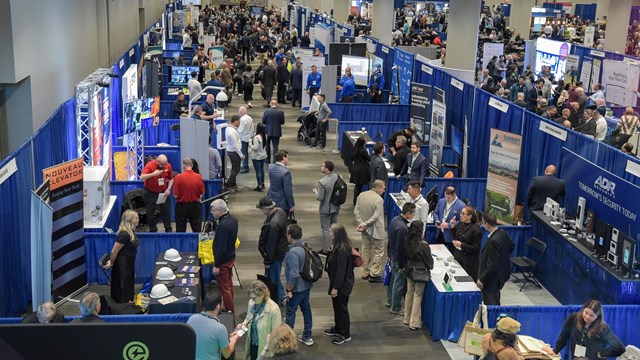When walls are the only separation between you and your neighbors, privacy sometimes goes out the window. People hear their next-door neighbors talking, footsteps from above or even music blaring through the walls. Sound transmission between units is one of the biggest complaints among condo association dwellers. Noise can also come from ceilings, doors and windows, so living in a multifamily building could take some getting used to.
Sound 101
The frequency of sound is expressed in wavelengths per second or cycles per second (CPS), which is more commonly referred to as hertz (Hz). Low frequency noise is considered 250 hertz and below, while high frequency noise is 2000 Hz and above. Mid-frequency noise falls between 250 and 2000 Hz.
The amplitude of sound is expressed in decibels. This is a logarithmic compressed scale dealing in powers of 10 where small increments in dB correspond to large changes in acoustic energy.
While some noise in shared living spaces is normal, if you can clearly hear your neighbors’ conversations or TV through your walls or ceiling, you have a noise problem. If you’re willing to make the financial investment, there are innovative noise reduction solutions that can turn an older condo association unit into a sanctuary of peace and quiet.
The most problematic waves are low-end frequencies—bass signals, in other words. If you can imagine the noise transfer you hear from a closed room,” says Keith Barkman, senior project manager at Sound Management Group in Hillsborough, New Jersey. “If you're in a closed room and you hear the conversation from another room. You probably won't hear the mid-range frequencies; you'll hear the lower range, bass frequencies of the voices.”
“A lot of times, low-end frequency will be transmitted through the wall, and actually transfer into structural noise. That could be a system that creates that—a fridge, a computer, or generators. We've run into a host of different issues that are both airborne and structure-borne,” says Barkman.
Many buildings now use concrete structures that support more units and floors. Concrete may be more durable, but sound-wise, it can pose a challenge. One of the biggest misconceptions is that people who live in units with concrete slabs for walls and ceilings will be immune to any noise issues. In predominantly wooden structures, it's the low-frequency sounds—such as heavy footfalls— that come through, whereas in a concrete structure, one gets more the higher-end, clickety-clacking noise from heels, as well as those mechanical vibrations that resonate especially well through concrete.
When a sound wave hits one side of a wall it transforms into a vibration, which will travel from the sheetrock, to the stud and into the sheetrock on the other side of the wall. Because it does not have any other hard surfaces to travel through, it becomes an airborne sound again.
“You can measure it with a sound meter,” says Bob Orther, president and senior technical advisor for Soundproofing America, a national company. “The way they come up with the [Impact Insulation Class] IIC rating is with a hammer test. They go upstairs and hammer the floor, and look at the decibels down below.”
Combating the Clatter
Unfortunately, many contractors and developers are not well educated when it comes to soundproofing standards and installation. Federal housing developments follow fairly strict guidelines for soundproofing that include expensive sound testing for the units. But, private condo association developers rarely adhere to the same standards or test the materials that are being used to help with soundproofing.
“There are a couple different indicators as far as how we measure these materials, and what we can expect from the materials in the field,” says Barkman. “Basically, we look at the amount of sound attenuation that a certain product has. So how many decibels does a product cut down? If you have a wall configuration that is built to have a 45 STC (Sound Transmission Class), that's a pretty high-performing wall. They say that the uniform commercial code, the walls are supposed to have a field-performing 40 STC, but that is usually not the case. More often we see walls performing in the mid- to high 20s, and that's where you start to get into issues.”
There's no one industry-wide accepted method of soundproofing, and that's at least in part because none of them completely get rid of every single sound. But, other than retrofitting your entire ceiling with new insulation and drywall, certain materials can help dampen sound. “There's a vinyl material that's really great at blocking airborne sound, but impact noise is a hard animal to combat. A concrete structure, you're not going to have a problem with airborne noises like you would with a wood structure. Wood in general is not really a good sound-proofer, but if it's dense enough it can be,” says Orther.
Wall to Wall Action
Common wall dwellings have to meet certain codes that are set in place by either the local building code or the national building council. A unit of measure called Sound Transmission Class (STC) will tell you how soundproof a wall or ceiling is. In most urban areas, a unit must have an STC of around 50 to be within code. According to industry experts, an STC of 40 is the onset of privacy. Once it hits 50, very loud sounds such as musical instruments can barely be heard. At 60, most sounds are inaudible.
Gene Ferrara, owner of JMA Consultants & Engineers P.C., in Englewood Cliffs, says that for soundproofing a residence, it’s important to minimize vibration from one surface to another and the best way to do that is by adding shock absorbers between the ceiling or wall in an existing structure. “Because most buildings are made of concrete, walls and ceilings will need to be framed, lowered or extended for space,” he says. “It could take anywhere from three days to two weeks depending on the scope of the project.”
One option is to install acoustical insulation, although that means taking walls down to the studs. Another alternative is using dB-Bloc, a vinyl sound barrier material, which can be layered behind drywall or other finished wall or ceiling surfaces to help block noise transmission through common walls. Diffusers and reflectors can also be used to reshape reflective energy where walls and ceilings create acoustical mirrors. Diffusers and reflectors keep volume the same as untreated walls and ceilings while changing the shape of the noise.
One way to reduce noise for people below you is by carpeting the floor. The problem is many people like hardwood floors or decorative ceramic tile, so in these cases it's crucial to install a sound-absorbing acoustical mat before laying down the floor. A noise issue arises when whoever is living upstairs decides they don’t like carpeting, installs wood floors and doesn’t put in a soundproofing mat or agent underneath, says Orther. “And they're usually doing it illegally, because most condo associations require an STC. But, the main thing they're concerned with is IIC, what's called an impact insulation coefficient.”
It’s not just the walls and ceilings you have to worry about when it comes to noise. Noise can sneak in through any gaps in openings, including doors, windows, outlets, switch boxes, HVAC openings, and anywhere building materials meet. “I always tell people, do not put recessed lights in your ceiling, because that's just a big hole in your ceiling. That said, if you have a concrete ceiling, it might not be a problem because you're talking about the impact noise. It will come through the lights,” says Orther.
Sealers can be very cost-effective sound-killers, yet they are often the most overlooked step in noise control solutions. These can include door seals, automatic door bottoms, thresholds, and acoustical caulk. Also good for soundproofing are noise barriers, which are always high density, massive, heavy materials and are essential for eliminating noise transmission.
Of all the things to get upset about when living close to others, sound issues seem to be among the most incendiary. Lawsuits related to noise complaints are not uncommon, and some associations are taking matters seriously. “If there is a provision in the bylaws, and they don't meet that, then there's a serious problem. But there's things they can put under the floor. For some reason recycled tires works great for stopping impact noises going down,” says Orther.
Final Thoughts
While some of today's condo association developers are taking more proactive steps to incorporate noise control features during the construction process, even newer buildings with concrete ceilings face many older developments where noise between units is a big issue. “A lot of the problem is contractors do not have a clue about soundproofing. If they did, they would save a lot of money on lawsuits. Because if a condo association just gets put up, and residents immediately have issues, they go to the contractors,” says Orther.
It almost goes without saying that some unit owners can obsess over sounds, especially when trying to sleep or relax. But, even the highest-end soundproofing methods can't get rid of every single sound. Industry experts agree that if you're going to spend tens of thousands of dollars on retrofitting your home for sound, don't expect a cure-all. Living above, below, and next to fellow owners, you will likely from time to time be reminded that you're not the only one in the building.
Keith Loria is a freelance writer and a frequent contributor to The New Jersey Cooperator. Editorial Assistant Tom Lisi contributed to this article.





Leave a Comment